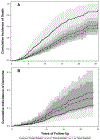Tobacco Smoking and Dementia in a Kentucky Cohort: A Competing Risk Analysis
- PMID: 30856115
- PMCID: PMC6915304
- DOI: 10.3233/JAD-181119
Tobacco Smoking and Dementia in a Kentucky Cohort: A Competing Risk Analysis
Abstract
Tobacco smoking was examined as a risk for dementia and neuropathological burden in 531 initially cognitively normal older adults followed longitudinally at the University of Kentucky's Alzheimer's Disease Center. The cohort was followed for an average of 11.5 years; 111 (20.9%) participants were diagnosed with dementia, while 242 (45.6%) died without dementia. At baseline, 49 (9.2%) participants reported current smoking (median pack-years = 47.3) and 231 (43.5%) former smoking (median pack-years = 24.5). The hazard ratio (HR) for dementia for former smokers versus never smokers based on the Cox model was 1.64 (95% CI: 1.09, 2.46), while the HR for current smokers versus never smokers was 1.20 (0.50, 2.87). However, the Fine-Gray model, which accounts for the competing risk of death without dementia, yielded a subdistribution hazard ratio (sHR) = 1.21 (0.81, 1.80) for former and 0.70 (0.30, 1.64) for current smokers. In contrast, current smoking increased incidence of death without dementia (sHR = 2.38; 1.52, 3.72). All analyses were adjusted for baseline age, education, sex, diabetes, head injury, hypertension, overweight, APOEɛ4, family history of dementia, and use of hormone replacement therapy. Once adjusted for the competing risk of death without dementia, smoking was not associated with incident dementia. This finding was supported by neuropathology on 302 of the participants.
Keywords: Competing risks; dementia; dementia free death; lifetime smoking.
Conflict of interest statement
The authors report no conflicts of interest.
Figures

References
-
- Anstey KJ, von Sanden C, Salim A, O’Kearney R (2007) Smoking as a risk factor for dementia and cognitive decline: a meta-analysis of prospective studies. Am J Epidemiol 166, 367–78. - PubMed
-
- Norton S, Matthews FE, Barnes DE, Yaffe K, Bryne C (2014) Potential for primary prevention of Alzheimer’s disease: an analysis of population-based data. Lancet Neurol 13, 788–94. - PubMed
Publication types
MeSH terms
Grants and funding
LinkOut - more resources
Full Text Sources
Medical

